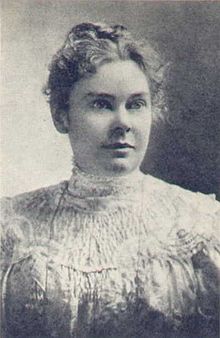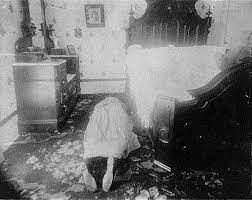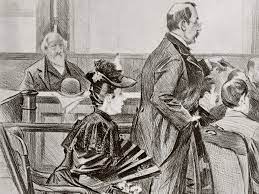Back in 1892, the well-to-do Borden household became the stage for one of the most horrifying murders in broad daylight, a shocking event that reverberated throughout the entire nation.
Today, this historic house offers an opportunity to step back in time, immersing yourself in the chilling atmosphere of that fateful day.
Moreover, for those with a taste for the supernatural, you can also embark on ghost hunts in this haunted locale, delving into the eerie mysteries that still linger on these grounds.
Below, I will break down everything you need to know about the Lizzie Borden House.
Table of Contents
What is the Lizzie Borden House?
Nestled in Fall River, Massachusetts, the Lizzie Borden House stands as the eerie backdrop to an unsolved, gruesome double axe murder that sent shockwaves across the globe in 1892.
Beyond its historical notoriety, this place has gained a reputation as one of the most haunted locations in the country. Brave visitors have the option to explore the house through guided tours or even spend the night there as BnB guests, embarking on an adventure that blurs the lines between history and the supernatural.
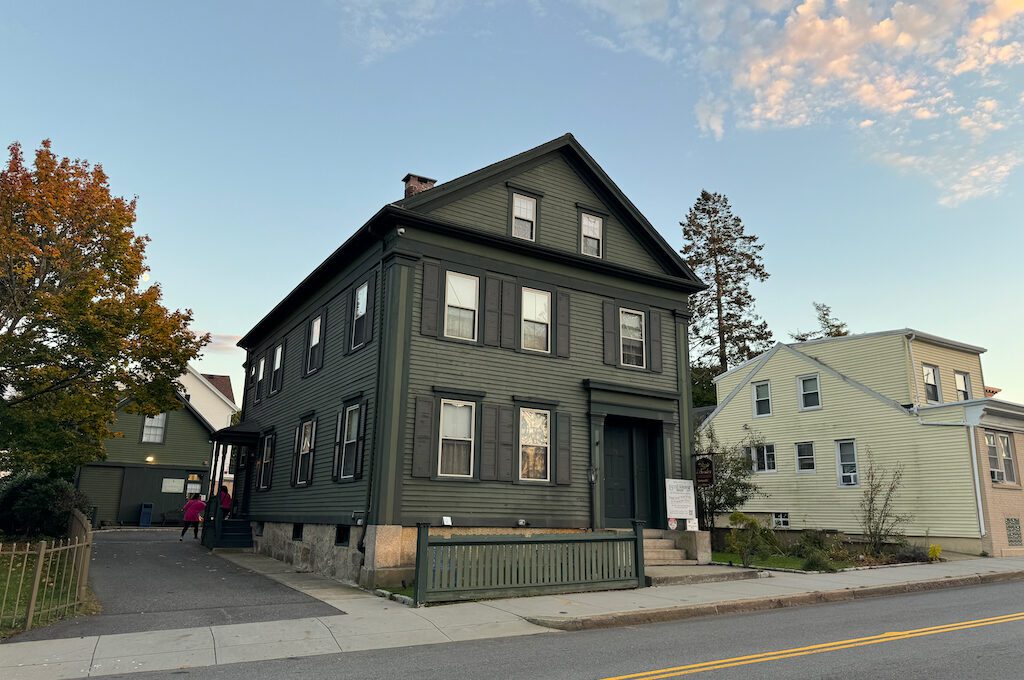
Background on the brutal murders
To understand the murders and Lizzie’s potential culpability, you need to understand the family dynamics at play.
Andrew Borden, the patriarch in this narrative, steadily climbed the social ladder, progressing from an undertaker to a prominent figure in the business world.
Despite amassing a considerable fortune, estimated at around $10 million in today’s currency, he was widely recognized for his steadfast frugality.
This penchant for thriftiness might have contributed to the resentment harbored by his daughter, Lizzie.
It’s somewhat perplexing that with their financial means, Andrew chose to reside in a home devoid of modern conveniences such as plumbing and electricity. Meanwhile, Lizzie aspired to emulate the lifestyle of the affluent. But she never had the opportunity to do so and instead had to live with a less than ideal family situation.
Lizzie’s mother had passed away when she was a mere two years old, and just three years after this loss, her father, Andrew, entered into a love-less union with Abby Gray.
The relationship between Lizzie and Abby was far from harmonious, as Lizzie often avoided her at meal times and referred to her as “Mrs. Borden,” along with a number of unflattering monikers.
Lizzie and her older sister, Emma, defied the norms of their time by remaining unmarried (“spinsters”), a choice that raised eyebrows in the conservative late 1800s society.
Rather than pursuing the typical avenues of a social life, Lizzie channeled her energies into religious pursuits. She dedicated herself to teaching Sunday school to the children of recent immigrants and actively participated in various religious organizations, including the Christian Endeavor Society.
However, her life was far from saintly, as she had a notorious reputation as a thief. Given her flaws and the turmoil within her family, it’s evident that Lizzie grappled with her inner demons.
Adding further complexity to the narrative is the suggestion of long-standing tensions with her father, possibly stemming from instances of abuse. Some sources suggest the existence of incestuous and predatory behavior on Andrew’s part, although the veracity of such claims remains uncertain.
Borden family disputes were not uncommon, with a significant one arising from Andrew gifting a house to Abby, who, in turn, allowed her sister to reside there. This arrangement likely exacerbated their already strained relationship and may have sparked worries in Lizzie’s mind about how her father’s estate would be handled.
It’s entirely plausible that Lizzie understood the potential implications of her inheritance should her father pass away before Abby.
In the months leading up to the gruesome murders, it appears that the mounting tension within the family was reaching a breaking point. In May 1892, a distressing incident unfolded when Andrew, in an attempt to deter local children who were drawn to Lizzie’s pigeons, reportedly wielded a hatchet in the barn and may have killed some of her cherished birds.
Further signs of the family’s discord emerged in July 1892 when a heated family argument flared up and prompted both Lizzie and her sister to embark on extended “vacations” in New Bedford, a move that underscored the palpable discord in the Borden household.
To complicate matters, a break-in occurred at the Borden residence that same summer. Lizzie, with a sense of foreboding, began to fear that something ominous was looming on the horizon.
In fact, she confided in a friend, expressing her suspicion that her family, who had fallen ill, might have been poisoned on the day preceding the fateful murders and that she felt the need to sleep with one eye open.

The murder and investigation
On that fateful Thursday, August 4, 1892, Abby directed the household maid, Bridget Sullivan, to get to cleaning the windows.
She then ascended the stairs sometime between 9:00 am and 10:30 am to tidy up the bedroom that Lizzie’s maternal uncle was staying in (he was currently out of town).
Little did Abby know that her morning chores would end in such a gruesome tragedy. Abby was struck in the head by an axe and subsequently endured a brutal assault, sustaining 17 blows as she lay helpless on the floor.
Meanwhile, around 11 AM, Andrew returned home.
Unbeknownst to him, the nightmarish scene of violence had already unfolded upstairs. Andrew settled downstairs, blissfully unaware of the grisly events that had transpired above. He relaxed in his chair, seeking a midday nap, only to have his slumber disrupted by a merciless attack, with a hatchet-like weapon striking him a devastating ten to eleven times.
The aftermath of these horrific events led to a perplexing investigation and inquest.
Lizzie, under the influence of prescribed morphine, offered a series of contradictory accounts regarding the incidents. When asked about her whereabouts during the killings, she claimed to be ironing handkerchiefs in the kitchen; and the next moment, she recounted searching for fishing sinkers in the barn or enjoying a leisurely snack of pears.
The inconsistencies in her statements left investigators scratching their heads. Some observers also noted her unusual calm and poise during the interviews, which only deepened the mystery surrounding the case.
It was these conflicting statements, also delivered during the inquest, that ultimately prompted her arrest. Lizzie found herself indicted and, subsequently, faced trial in June 1893, marking the beginning of a legal battle that would captivate the nation.
During the trial, the skulls of the victims were admitted as evidence and made a chilling appearance in the courtroom, which had a profound impact on the proceedings. At the sight of these macabre artifacts, a mostly composed Lizzie even fainted.
Yet, it’s equally noteworthy what evidence was left out of the trial and what captured the headlines.
The conflicting statements made by Lizzie during the inquest were omitted from the proceedings since it was determined that she had been under the influence of medically prescribed morphine when she provided those accounts.
Another eyebrow-raising detail was Lizzie’s attempt to purchase a form of poison called “hydrocyanic acid” the day before the murders. It certainly raised suspicion but was ultimately ruled as irrelevant by the court.
It’s worth noting the quality of Lizzie’s defense team. Spearheading her legal defense was George Robinson, a former Massachusetts governor who had previously appointed the very judge overseeing the trial.
The defense team also included prominent attorneys, one of whom, William Henry Moody, would later ascend to the Supreme Court.
Despite all the inadmissible evidence, there were some compelling pieces of evidence that appeared to work against Lizzie. For example, her decision to destroy a dress she claimed had “paint” on it raised questions though it was backed up by other testimony.
Furthermore, when initially questioned about Abby’s whereabouts after Andrew’s body was discovered, Lizzie informed others that Abby was out attending to someone based on a note Lizzie had delivered to her. However, no evidence of this note ever surfaced.
The jury, after receiving acquittal-friendly charge instructions from the judge, reportedly reached their verdict within 20 to 30 minutes.
They only extended their deliberation to an hour and a half to avoid controversy.
In the end, they acquitted Lizzie Borden of both murders.
The lack of concrete direct evidence, combined with the seemingly improbable notion of a woman of Lizzie’s social standing committing such a brutal act, likely played a pivotal role in their decision.

Post trial-life and legacy
After the trial, the Borden sisters moved into a large, modern house in The Hill neighborhood in Fall River.
Despite the acquittal, Lizzie was ostracized by Fall River society and the sisters eventually had a falling out and didn’t speak to each other for decades. Lizzie went on to live a pretty admirable life becoming a major benefactor for charitable causes such as animal shelters until her death in 1927.
The story went on to be heavily documented in various forms of media over the decades.
There are several movies made with the one called The Legend of Lizzie Borden, featuring Elizabeth Montgomery (who was a distant relative of Lizzie’s) being the gold standard. Cara Robertson’s “The Trial of Lizzie Borden” is one of the many pieces of literature also worth checking out.
Here are a few good documentaries to watch as well:
The brutal butchering went on to be remembered in a jump roping nursery rhyme popular in New England that went like this:
Lizzie Borden took an axe
and gave her mother forty whacks.
When she saw what she had done,
she gave her father forty-one.
Lizzie Borden House Hauntings
One of the biggest draws to the Lizzie Borden house is the fact that it remains among the most haunted places in Massachusetts and even the entire country.
For those daring enough to delve into the eerie mysteries of the place, you can opt for an evening ghost tour or immerse yourself in a spine-tingling ghost hunt. These paranormal excursions have left visitors with a spectrum of spine-tingling sensations.
Imagine feeling an inexplicable chill as if a phantom flame were trailing along your back.
Participants frequently recount encounters with ghostly reflections, as if the spirits of the past are making their presence known in the present. These experiences offer a glimpse into the enigmatic world of the paranormal, where the boundary between the living and the departed blurs, leaving participants with a taste of the unexplainable.
There’s also the option of staying at the BnB overnight if you are up for that challenge.

The Lizzie Borden House experience
We opted for a 4 pm house tour, keeping our ghostly inclinations in check.
The idea of a ghost tour or even a ghost hunt did cross our minds, especially after my recent attempt to encounter the otherworldly at the Stanley Hotel in Estes Park, Colorado.
However, we settled for the more mild adventure to see where it would lead us, although the ghost hunts certainly beckon to those with a thirst for the supernatural.
Upon arrival, you’ll find yourself at the gift shop in the old barn, where you can check in. Inside, a map allows visitors to place their initials on a sticker, marking their place of origin. It’s intriguing to see how people from all corners of the globe have made the pilgrimage to this haunted haven.
While waiting for the tour to commence, you can leisurely explore the gift shop, where a treasure trove of memorabilia and artifacts awaits. You’ll find an array of newspaper clippings, photographs, and house-related artifacts, offering a tangible connection to the history of the place.
When it was time to kick off the tour, our animated and theatrical guide assembled us in the parking lot, which, interestingly, used to be the old pear orchard. From there, we stepped into the house and commenced our exploration in the sitting room. I managed to snag a seat right where Lizzie Borden herself was arrested.

Our guide, as previously mentioned, was a master of drama and kept us thoroughly engaged.
Despite having delved deep into the incident over the past couple of days, I was pleasantly surprised to uncover a wealth of new information during the tour.
The tour is expertly structured, leading you from room to room, allowing you to unravel both the mysteries of the past and the supernatural aspects that cling to this historic home.
Inside some of the rooms, you’ll come across a fascinating array of artifacts and intriguing details. One notable highlight is the dress featured in the legendary Lizzie movie starring Elizabeth Montgomery. But it’s not all cinematic history; you’ll also be presented with chilling glimpses of the gruesome past, including some photographs from the murder scenes.
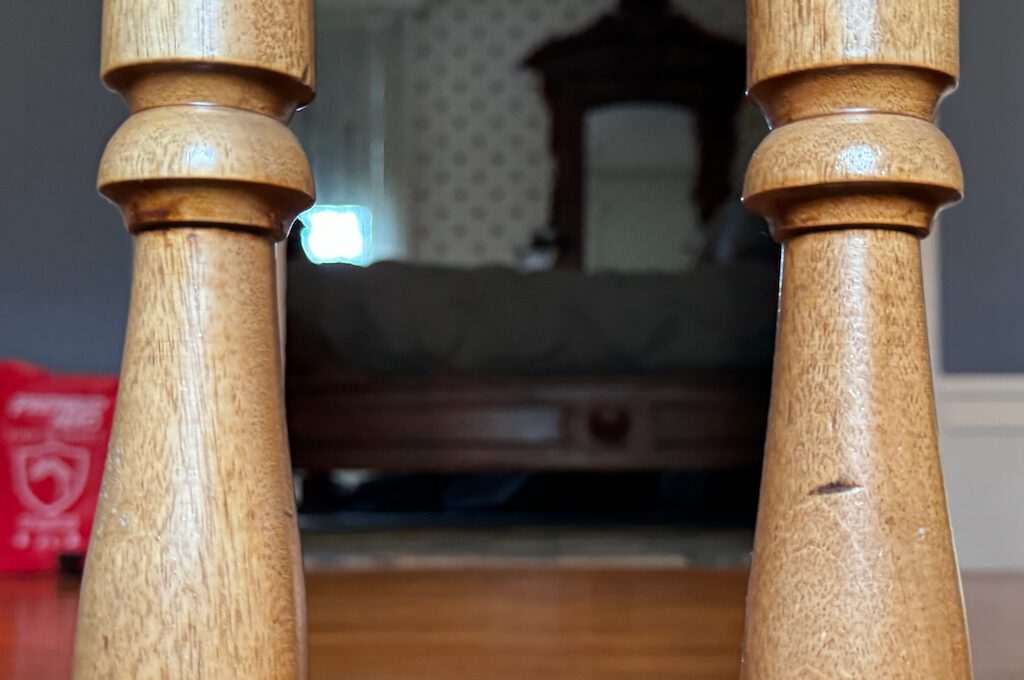
During the tour, you’ll even have the chance to reenact some of the famous crime scene photos, so there’s no need to be bashful.
As you enter some of the rooms, it’s a surreal experience, especially when standing in the very spot where Abby Borden met her tragic end.

I was particularly drawn to the bedrooms, where I could envision how an overnight stay would be a truly immersive and captivating experience. The photos and decor in these rooms really set the mood, making it a worthwhile endeavor for those looking to delve even deeper into the mysteries that shroud this historic house.

The tour offers a comprehensive journey through the entire house, including the attic, which served as the living quarters for the maid, Bridget. It was fascinating to delve into her story, learning about her experiences within the house and what her life entailed after her time there.
As we concluded the tour, we descended into the dark and mysterious depths of the basement. This is purportedly the epicenter of much of the paranormal activity.
Guides point out spots where intriguing signs of supernatural occurrences have been noted, and you might even catch a glimpse of the eerie remnants of bloodstains still embedded in the wood from the tragic murder of Andrew Borden. It’s a chilling conclusion to an already haunting journey through this enigmatic house.
Final word
In sum, this was an extraordinary experience. Prior to my visit, I was in the dark about the Lizzie Borden murders, but this tour illuminated the full story, revealing the many different angles from which one can interpret these events. The paranormal dimension of the visit adds an extra layer of intrigue that’s bound to captivate many.
All in all, I believe that this tour is an absolute must-visit. I wholeheartedly recommend it to anyone who possesses even a passing curiosity about these historic events. It’s a journey that not only educates but also leaves you with a profound sense of wonder and mystery.
Daniel Gillaspia is the Founder of UponArriving.com and the credit card app, WalletFlo. He is a former attorney turned travel expert covering destinations along with TSA, airline, and hotel policies. Since 2014, his content has been featured in publications such as National Geographic, Smithsonian Magazine, and CNBC. Read my bio.


